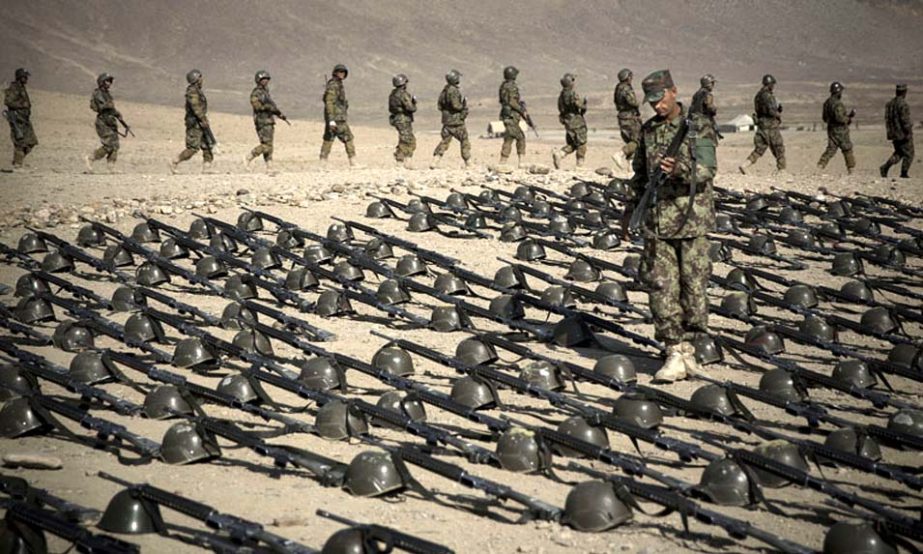
AFP, Washington :
Afghan security forces are suffering heavy casualties on the battlefield and large numbers of troops are resigning or deserting their units, a new report said Tuesday.
The US military also has overestimated the size of the Afghan police and army by a significant margin, the special inspector general for Afghanistan reconstruction, John Sopko, said in a report to Congress.
The Afghan army “continues to suffer serious combat losses,” SIGAR wrote.
Between October 2013 and September 2014, more than 1,300 Afghan army troops were killed in action and 6,200 were wounded.
The Pentagon insists the Afghan forces are holding their own against Taliban insurgents after the bulk of NATO combat forces withdrew last year. But senior US officers have voiced concern over the “unsustainable” casualty rate.
Apart from high causalities, the Afghan national security forces face a persistent problem trying to retain those who joined the police and the army, the report said.
“Attrition continues to be a major challenge for the ANSF,” it said. “Between September 2013 and September 2014, more than 40,000 personnel were dropped from ANA (Afghan National Army) rolls.”
The high attrition rate has plagued Kabul for years and NATO advisers have struggled to stem the problem.
The report also sharply criticized the US military mission in Afghanistan for revising the estimate for the total strength of the Afghan army.
Commanders informed the inspector general of the lower number only hours before its report to Congress was due to be released.
The Afghan army now stands at 169,203 troops, a drop of 8.5 percent or about 15,000 soldiers. That marked the lowest troop strength for the Afghan army since August 2011.
The United States and its allies have poured huge sums into training and arming the Afghan forces and the inconsistent accounts on the size of the army represent “long-standing and ongoing problems with accountability and personnel tracking,” the inspector general said.
Given that an accurate accounting of the ANSF’s size was a key factor in assessing the pace of a US troop withdrawal and that Washington was paying to train and equip the Afghan troops, “these inconsistencies are deeply troubling,” the report said.
US policymakers need accurate data on the Afghan security forces to make “informed decisions,” it stressed.
In January, the US commander in Afghanistan, General John Campbell, was at odds with the inspector general after his office initially refused to allow the public release of facts and figures about the Afghan forces.
But Campbell reversed his decision days later and most of the data was released.
Afghan security forces are suffering heavy casualties on the battlefield and large numbers of troops are resigning or deserting their units, a new report said Tuesday.
The US military also has overestimated the size of the Afghan police and army by a significant margin, the special inspector general for Afghanistan reconstruction, John Sopko, said in a report to Congress.
The Afghan army “continues to suffer serious combat losses,” SIGAR wrote.
Between October 2013 and September 2014, more than 1,300 Afghan army troops were killed in action and 6,200 were wounded.
The Pentagon insists the Afghan forces are holding their own against Taliban insurgents after the bulk of NATO combat forces withdrew last year. But senior US officers have voiced concern over the “unsustainable” casualty rate.
Apart from high causalities, the Afghan national security forces face a persistent problem trying to retain those who joined the police and the army, the report said.
“Attrition continues to be a major challenge for the ANSF,” it said. “Between September 2013 and September 2014, more than 40,000 personnel were dropped from ANA (Afghan National Army) rolls.”
The high attrition rate has plagued Kabul for years and NATO advisers have struggled to stem the problem.
The report also sharply criticized the US military mission in Afghanistan for revising the estimate for the total strength of the Afghan army.
Commanders informed the inspector general of the lower number only hours before its report to Congress was due to be released.
The Afghan army now stands at 169,203 troops, a drop of 8.5 percent or about 15,000 soldiers. That marked the lowest troop strength for the Afghan army since August 2011.
The United States and its allies have poured huge sums into training and arming the Afghan forces and the inconsistent accounts on the size of the army represent “long-standing and ongoing problems with accountability and personnel tracking,” the inspector general said.
Given that an accurate accounting of the ANSF’s size was a key factor in assessing the pace of a US troop withdrawal and that Washington was paying to train and equip the Afghan troops, “these inconsistencies are deeply troubling,” the report said.
US policymakers need accurate data on the Afghan security forces to make “informed decisions,” it stressed.
In January, the US commander in Afghanistan, General John Campbell, was at odds with the inspector general after his office initially refused to allow the public release of facts and figures about the Afghan forces.
But Campbell reversed his decision days later and most of the data was released.

